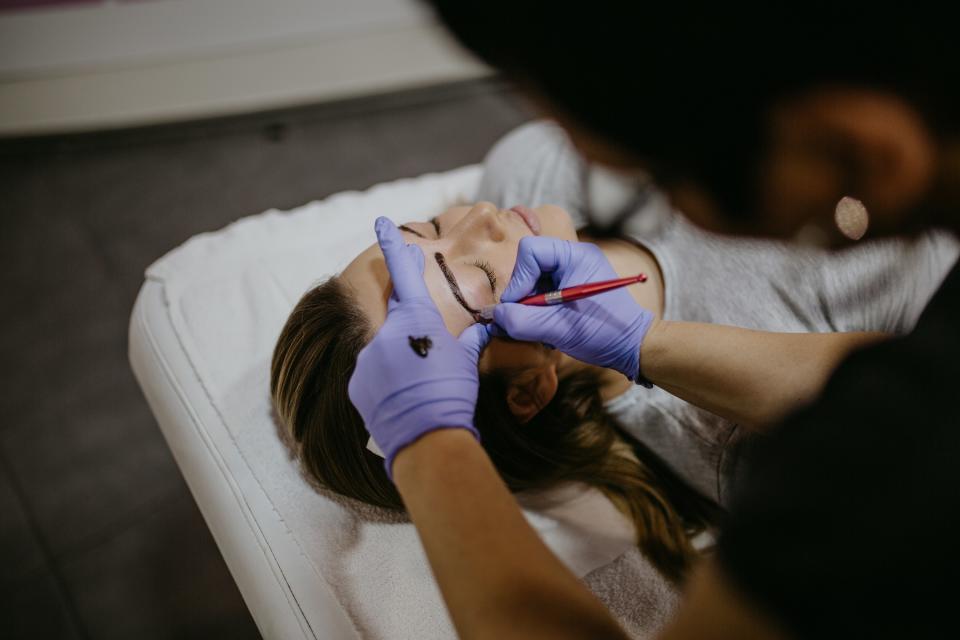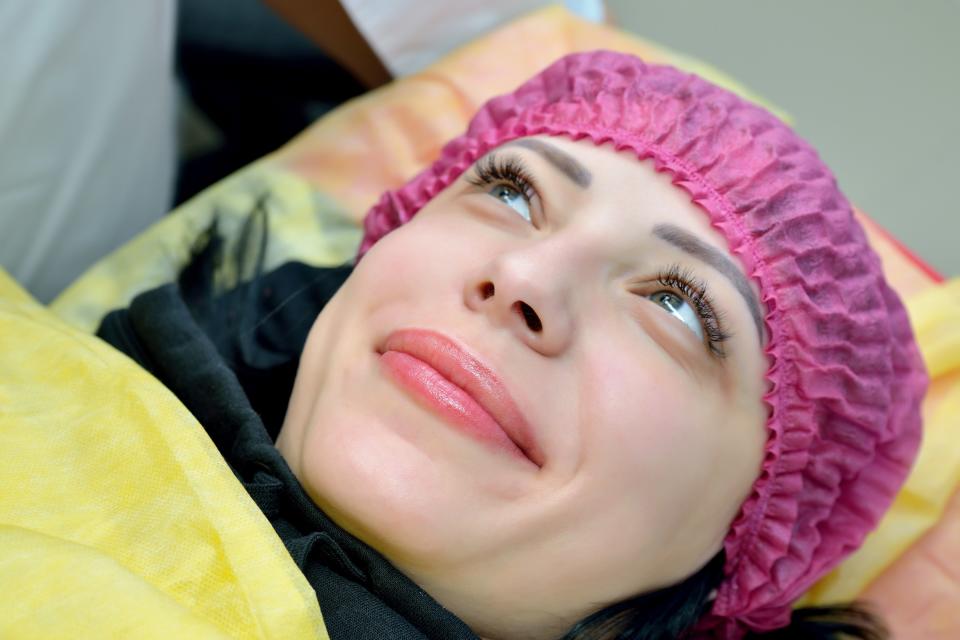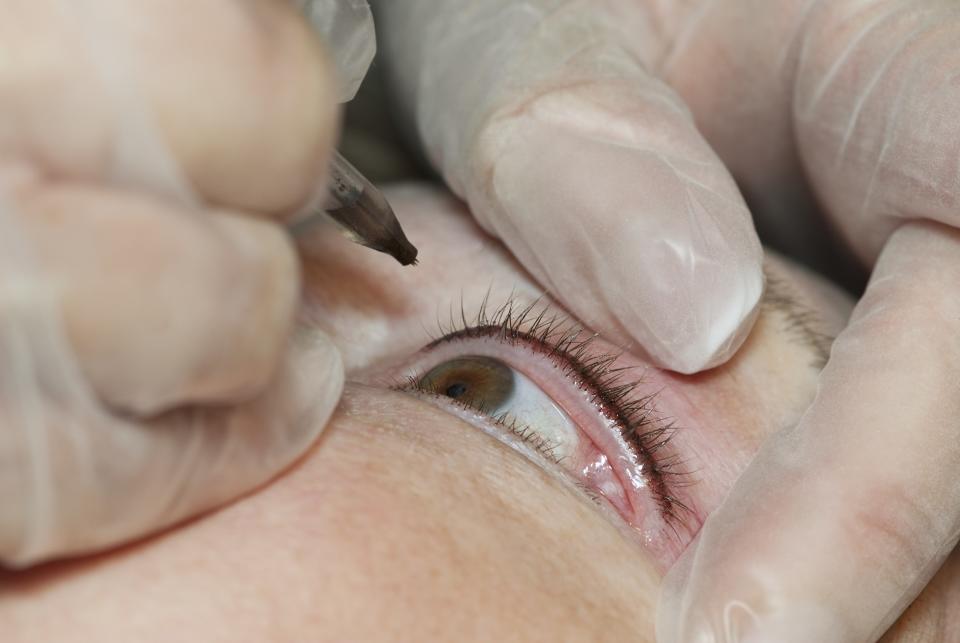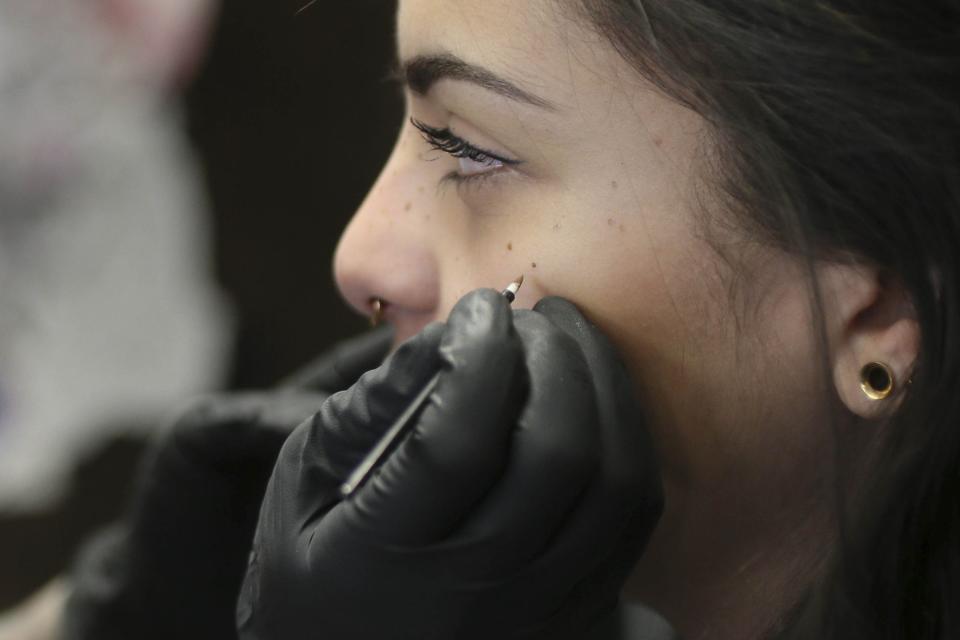The Ultimate Guide to Permanent Makeup
You've just rolled out of bed. Your blowout is intact. You grab a bottle of Soylent, throw on yesterday's jeans, and get out of the house in under three minutes. Either you're living in 2069 and have purchased a Jaclyn Hill x Google in-home makeup artist...or you have a face full of semipermanent cosmetic tattoos.
Chances are, you've already heard of microblading. Thanks to an exponentially exploding interest in brows over the past few years, the eyebrow-tattooing technique has gone practically mainstream. But brows are just the beginning. Cosmetic makeup artists are also inking on freckles, lip colors, and more — making it possible to wake up with a face full of makeup even here in 2019. But as cosmetic ink gets more common, it's important to remember that the key term in semipermanent makeup is "permanent."
"Clients come in and say, 'I’d never get a body tattoo,' and in my mind, I’m like, 'You know you're tattooing your face right now,'" laughs Kendra Bray, owner of New York City salon Better Brows & Beauty. Here's exactly what you need to know about microblading, lip blushing, blush tattoos, eyeliner tattoos, freckle tattoos, and scar camouflage before the moment that needle hits your face.
1. Microblading

Permanent Make-Up und Microblading
Getty ImagesHow does it all work?
Microblading, the most popular form of permanent makeup, is a fancy name for an eyebrow tattoo. Instead of the shockingly dark brows you may have seen on members of the Silent Generation, the modern technique simulates individual hair strokes for a natural look. Cosmetic tattoo artists use a super fine pen to deposit pigment directly under the skin. You may also hear names like brow feathering or microshading. "People will claim different techniques for marketing purposes," says Bray. Other techniques still fall under the umbrella of natural-looking hair strokes, and the important part is to study examples of your artist's work and make sure you're a fan before booking an appointment.
Who does it work for?
If filling in your brows is a crucial part of your beauty routine, you might want to look into microblading. To its credit, the procedure is dermatologist-approved. "I think it is an ideal treatment for restoration of the eyebrows," says board-certified L.A.-based dermatologist Ava Shamban. She's such a fan of the procedure that she even does microblading procedures in her own clinics. There's one major pro to getting your work done at a dermatologist's office: "We can be prepared for the unforeseen complications and act or react accordingly," says Shamban.
Even if you choose to go with a cosmetic tattoo artist without a medical degree, talk to your dermatologist to make sure your skin is amenable to a tattoo. Bray turns away potential clients with oily skin or large pores. "Microblading only looks great when you can achieve fine details," says Bray. "People with oily skin won't heal with the crisp strokes you need to achieve a natural look."
How long does it last?
Like any tattoo, microblading does fade over time. Expect to return to your artist after 12 to 18 months for a touch-up. Exactly when to come back is up to you: "The pigments are designed to slowly fade over time, so it’s a personal preference when to come in for maintenance once the color starts to lose concentration," says Bray. "Some people fade a little bit and they want more; others let it almost all fade out before they come back." At a maintenance appointment, the artist will add color concentration to the existing work.
What are the potential risks?
Infection is a potential risk for any permanent makeup tattoo (as well as just about any type of body tattoo). "With all of these, we are opening the skin and blood-borne pathogens can be spread, so you want to make sure technicians are using disposable, single-use tools," says Bray. Your technician should open the single-use tool in front of you. Infection can also occur if clients don't follow the proper aftercare, says Bray, which means keeping the area dry and staying out of the sun for about 10 days. Your artist should also schedule a follow-up appointment after six weeks or so to ensure the skin has healed properly and that you're happy with the results.
Aside from the medical risks, there's also the chance that you'll be unhappy with the finished work and stuck with brows you don't love for over a year. Research your artist to ensure their work resonates with your personal style.
Cost:
Tattooed brows will run you about $600 to $1,000, depending on the artist.
2. Lip Blushing

On the lips of the young woman applied pink paint to the needle during the procedure of permanent lip makeup. Extremely close-up. Shallow depth of field. Horizontal orientation of the image
How does it all work?
Lip tattoos may bring to mind the image of a fancy grande dame with permanent lip liner who never seems to actually fill in her lips. But according to Bray, the technique has been refined to its current form, known as lip blushing or lip tinting. The tattoo is a simple wash of sheer color across the entire lip. Bray works with her clients' natural lip shade to add a slightly deeper layer of pigment. The finished result should look like a just-bitten, blurred lip — the type of subtle color that looks like you've just enjoyed a makeout session.
Bray describes lip blushing as a "more intense" process compared to other permanent makeup tattoos. "Since the skin on the lips doesn't retain pigment as well as the rest of the skin, some clients require two or three touch-ups."
Who does it work for?
People who love the blurred-lip look and have a high pain tolerance.
"Lips are a lot more sensitive than the other parts of the face, so people do experience pain and swelling," says Bray. Expect to leave your appointment a little puffy and to spend a week looking like you just got fresh lip injections.
How long does it last?
Once you've been through the multiple touch-up appointments needed to first achieve your desired look, the color will last about a year.

A young girl with beautiful lips is lying in a beauty salon after the procedure of permanent makeup lips, smiling and looking up. Portrait. Lips close up. Horizontal orientation
What are the potential risks?
Shamban admits that she "isn't crazy" about lip-blushing tattoos. "There is a higher incidence of allergy to red pigment in the tattoo," she warns.
And in the unfortunate event that you do develop an allergy, be aware that there's no easy fix: "When correction laser is done to remove the red pigment, it almost always turns black," Shamban says. "Expertise, artistry, proper care, and advanced knowledge of the skin will give the patient the lowest risk of complications."
Cost:
Bray charges $1,400 for lip blushing, which includes touch-up appointments as needed to achieve your desired look.
3. Permanent Eyeliner

Close up of permanent makeup procedure on eye
Getty ImagesHow does it all work?
Eyeliner tattoos sit within or above the lash line to give the appearance of fuller lashes. Bray performs two types of liner tats: a traditional eyeliner tattoo and a lash line enhancement. The traditional tattoo is placed right above the lash line, leaving the effect of a distinct eyeliner line. The lash enhancement sits within the lash line for a more subtle, natural look. "If you're not wearing makeup, a lash enhancement will just leave you looking like you have fuller lashes," says Bray.
Who does it work for?
The person who always works out in mascara and refuses to leave home without their liquid eyeliner on.
How long does it last?
Lip blushing lasts about 12 to 18 months.
What are the potential risks?
As with brows and lips, the most prominent risk is an infection. Shamban approves of eyeliner tattoos as an "ideal" treatment for extra lash definition in some cases.
Cost:
That woke-up-like-this lip tint costs about $400 to $800.
4. Scar Camouflage
How does it all work?
Scar camouflage is a tattoo of the skin with flesh-colored pigment to mask a scar. The most well-known use is for mastectomy scars, although artists can cover various forms of scars, stretch marks, or acne scars.
Bossavy starts by assessing the scar and custom-blending a pigment to match her client's skin exactly. She implants the pigment in fine layers less than one millimeter below the skin's surface. The finished product will take two to three sessions, scheduled five to six weeks apart to allow for healing between each session.
Who does it work for?
Anyone with scars lighter than their natural skin color is a generally great candidate for this service. This treatment does not work well on scars that are brown, purple or red. When that's the case, laser and bleaching treatment should be done first, before undergoing the camouflage. While this treatment works well on hypertrophied scars, keloid scars are not a candidate for this treatment.
The scar (or stretch mark) also needs to be fully healed (taking usually eight to 12 months) so any residual redness or purple colors have totally dissipated and disappeared altogether, leaving the area with a disruption in the melanin production. "Because I deal with texture and color in one procedure, this works especially well on stretch marks, which have not only lost their melanin but their collagen and elastin as well," Bossavy explains. People who have hypopigmentation spots are also usually good candidates — again, because of the patches of skin that are lighter than your overall skin tone. Most often these are caused by acne or sun damage.
How long does it last?
Scar tissue has a thicker texture and no sweat glands, so scar camouflage lasts longer than other types of semipermanent makeup. Bossavy tells clients results will last for years, especially with minimal exposure to the sun and gentle skin care.
What are the potential risks?
According to Bossavy, the most common risk is shoddy artistry. "Some technicians just plaster together a mix of white and brown to try to resemble a skin tone," she says. "Because of the molecular structure of the color, the brown will most often turn orange over time and the white remains permanently bright, which has the opposite effect of making the scar even more obvious." As with every type of permanent makeup, do your homework and make sure your artist's technique resonates with you.
Cost:
Price varies depending on scar size, but expect a range from $2,500 to $4,500.
5. Freckle Tattoos

Freckle Tattoo
How does it all work?
Think of freckle tattoos as the rebellious little sister of the permanent makeup industry. Some artists don't perform them due to the difficulty of maintaining an even fade on the face, while others would argue that freckles are naturally uneven anyway. New York City–based cosmetic tattoo artist Bethany Wolosky starts by drawing on individual freckles with an eyeliner pencil. She then uses a stick-and-poke technique — the method of tattooing with a single needle instead of a machine — to tattoo each freckle. (Each one takes about four or five pokes.) Using diluted pigment, she'll slowly build a freckled face until the freckles look soft, natural, and just under the skin. Once she's completed a first pass with the needle, she applies numbing cream to the client's face and goes in again to make some bigger or darker without extra discomfort.
Who does it work for?
Most of Wolosky's clients are people who had freckles as children. "They got older and decided to stay out of the sun, so their freckles went away," she says. "They want that youthful look without having to go out in the sun."
How long does it last?
Most clients return for a touch-up after a year or two, says Wolosky, depending on both how quickly the freckles fade and how dark they want the freckles to be. Skin-care products speed up the fading process, so expect to go back for maintenance appointments or let the tattoos fade entirely. One pro: Unlike other forms of permanent makeup, you can baby-step your way into freckle tattoos. (You can have a ranging amount of freckles, but you can't exactly have one eye permanently lined.) Clients often return to Wolosky and ask her to add more in.
What are the potential risks?
Freckles are "impossible to maintain," says semipermanent-cosmetic enhancement artist Dominique Bossavy. To be fair, every form of permanent makeup requires touch-ups, but facial tattoos are trickier since they may fade unevenly. Ask your artist for their touch-up policy (some charge per appointment, while others fold maintenance appointments into a higher initial fee), and ask to see photos of former clients to analyze how your artist's pigment looks as it fades.
Cost:
Wolosky charges $200.
6. Blush
How does it all work?
None of the professional artists I spoke with do blush tattoos. "Some cosmetic tattoos are more taboo than others, and blush on the cheeks is one of those," says Wolosky. The blushed area may not fade evenly, leaving you looking like you have unblended blush or worse, uneven red spots. Skin-care products and treatments could cause an uneven fade or lead to color breakdown. Since it's impossible to avoid applying any skin-care products (let alone the sun, which also causes fading), most professional artists won't tattoo permanent blush.
Cost:
Save your money.
More on permanent makeup:
Here's what we remember loving from the M.A.C. x Cinderella collection:

